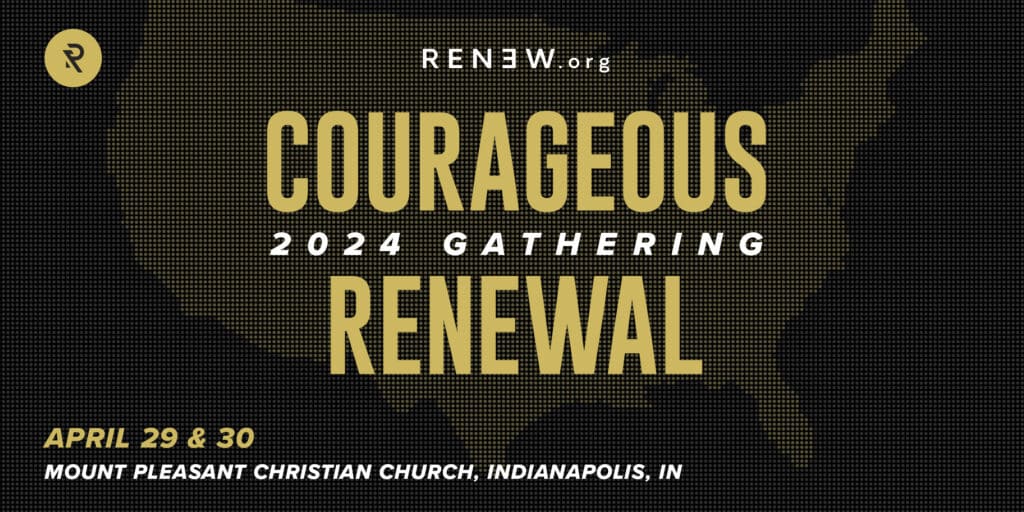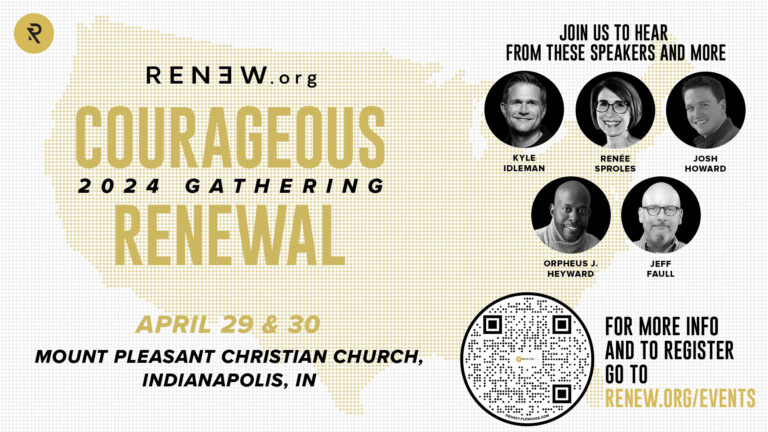Christianity in America seems more confusing than ever. Imagine American Christianity as a vehicle that seems to be breaking down on a long road trip. The check engine light is illuminated. The engine is sputtering. The flashers are engaged. The vehicle is pulled to the side of the road. Then, when concerned Christians pop and lift the hood on today’s Christianity, they find themselves overwhelmed with the smoke of misinformation and the heat of anger that seems to flood from the engine block.
A question that concerned Christians need to wrestle with is this: How do we cut through the smoke to understand what is really underneath the hood of American Christianity?
I want to introduce you to a tool that I call “The Four Tracks” that I have been thinking through for a couple years now. First, allow me to offer a couple caveats:
- These four tracks in American Christianity aren’t a perfect likeness. Every analogy breaks down at some point and this tool is no exception.
- This tool will only be helpful for those who approach it with a genuine desire to understand themselves and others.
I loathe—yes, I know that is a strong word—when Christians learn information only in order to load bullets to fire in their culture-war gun. In my opinion, merely learning in order to win sectarian arguments and deepen us in our already entrenched positions is rarely helpful for the future of Christianity.
“When concerned Christians pop and lift the hood on today’s Christianity, they find themselves overwhelmed with the smoke of misinformation and the heat of anger.”
So, I ask for one commitment as we approach this tool. Assume everyone started their spiritual journey with pure motives. We will need to be sober and direct about the incomplete and false gospels that are producing most of the smoke and heat described above. I hope, however, to do that with as much sensitivity as possible. Now let’s assemble this tool together.
Tug of War
This tool starts with an image of a tug-of-war. In this tug-of-war, every Christian must choose on which side of the rope they are going to place their hands, tighten their grip, and pull. The first tug-of-war is between cultural authority and biblical authority.

This tension isn’t new. When there is an impasse between biblical teachings and the predominant views of a culture, every Christian, like it or not, chooses either the Bible or the surrounding culture as their primary source to influence their thinking. This doesn’t mean that all who listen more to cultural authority are ignoring all biblical authority. It also doesn’t mean that those who choose the Bible as their primary source of influence fall outside of the influence of current or previous culture. Everyone’s heritage and upbringing influence the way they read and interpret Scripture.
However, what source should be considered primary for what is true or right, just and unjust? When there is tension between the teachings of the dominant culture and Scripture, which ought to conform to the other? Since interpretation involves contextualizing it into a particular cultural setting, people pulling on the side of cultural authority tend to be more open to the influence of contemporary movements, community consensus, and cultural-creeds over their interpretation of the biblical text; whereas those pulling for biblical authority would at least aim to discover the original meaning of a text and apply it in a way that translates into contemporary culture without being skewed by cultural values. Again, that’s the aim even if it is often easier in theory than in practice.
“When there is tension between the teachings of the dominant culture and Scripture, which ought to conform to the other?”
I do realize that there is some danger in drawing a direct contrast between cultural authority and biblical authority. There are times when those on the side of cultural authority and those on the side of biblical authority champion the same secondary causes. Please keep in mind, however, that this article primarily focuses on the question of core mission. What should the core mission of Christianity be?
People pulling for cultural authority will tend to champion a different core mission from those who pull for biblical authority. The purpose of this article and the corresponding diagram is to help the reader understand how the core mission in the life of a Christian or church has profound implications for the fullness of the Gospel that is accepted.
Understanding Cultural Authority
What I’m calling cultural authority, at least in present-day America, is often motivated from a deep empathy toward people and situations in our world. Out of compassion for the hurting, many feel a strong desire to act here-and-now to prevent the same hurt from happening again. Compassion and defending the oppressed are great qualities that align with both the life of Jesus and the values of our contemporary culture.
For those who are influenced more by cultural authority, it tends to be the hurt of others that fuels each cause they undertake. Thus, for those pulling toward cultural authority, the gravest sins tend to be less vertical (e.g., disobedience to God, rejecting his eternal salvation) and more horizontal: participating in anything that could cause hurt to others.
“For those who are influenced more by cultural authority, it tends to be the hurt of others that fuels each cause they undertake.”
Every Christian should ask, why am I fighting for this cause? Am I adopting causes of the hurting because I want to participate in God’s character, or is it because I am culturally compelled to do so? Does your motivation for good causes matter?
Understanding Biblical Authority
In the same way, those who pull on the side of biblical authority aren’t necessarily ignoring societal needs, hurts, or here-and-now solutions. Their hearts often break for the hurt and oppression of others too. They put their hope, however, in more long-term, God-driven solutions.
They believe Jesus’ salvation is the answer for healing the oppressed and transforming the oppressors from within. For them, the gospel includes justification, the Spirit’s renewal, and the hope of the future fulfillment of God’s kingdom. They believe that human organizations aren’t ultimately going to fix past hurt or prevent future oppression.
They believe that the primary mission of the church is to spread the gospel and the qualities of God’s kingdom everywhere they go. They believe it is only God’s brand of justice, holiness, righteousness, truth, grace, forgiveness, love, and mercy that will provide lasting relief to any form of brokenness. They believe that the Bible’s words carry more weight than the sentiments, stories, and hurts of others.
A Second Tug of War
At the same time, there is a second tug-of-war pulling at the fabric of American Christianity. This one is far simpler. On one end of the rope is the desire for change or progress. When I use the word “progress,” I mean it as value-neutral. I am not, at this point, trying to say that progress is good or bad. Progress simply means that there are Christians and churches that love to change and move. They will grip their hands on the side of progress and pull the rope with all of their might.

Those on the other end of this tug-of-war rope are those who prefer things to remain unchanged. Their mission is to keep things the same. At times, they may even appear to move—but it’s in a reactionary direction. For some, this could look like dismantling their faith, while, for others, it might mean further circling the wagons and remaining unchanged (as far as they are aware) by the surrounding culture. I will call this side static / regressive.
5 Missions
There are five groups and five core missions that emerge across these 4 quadrants. (Remember, even if these missions can look compatible with each other, we’re exploring which one people take to be their core mission, and as such, one will take priority over the others.) After we understand all five core missions and how these groups tend to think, we will add more nuance to this tool.

The top left quadrant represents those who operate with a high view of biblical authority and low view of progress. Their unspoken primary mission is to keep God’s commands to pursue correct religion.
In the top right quadrant are Christians who operate with a high degree of biblical authority and also a high desire for progress. Taking their cues from what they see commanded and modeled in the New Testament, their core mission is to grow God’s kingdom by making disciples of Jesus.
The bottom right quadrant represents those who operate with a high desire for progress and a high degree of cultural authority. Leaning toward the tenets of modern secular culture, their mission becomes to defend the oppressed. These individuals and churches often take their cues from whom they see as the most enlightened and compassionate cultural voices.
The bottom left quadrant illustrates Christians who operate out of a high degree of cultural authority and yet a low desire to see progress. Their journey starts with a questioning of faith and revealing of doubts. If pursued fully, this path leads toward a cynical deconstruction and, eventually, deconversion from faith altogether.
“If pursued fully, this path leads toward deconversion from faith altogether.”
The fifth group rests in the center of these four quadrants. For people who set up camp in this group, the primary mission is discovery. This type of discovery can be either intellectual or spiritual in nature. Those who remain in this centralized group are most driven by a life of improving self, discovering insights, and understanding the ideas and philosophies of others.
Exploring the Five Groups
As we dig deeper into each group and its mission, it is important to know that these broad labels don’t tell the whole story. I freely admit the complexities and disagreements within Christianity can’t be reduced to five static groups. However, since Christians are often exclusively described in two groups, conservatives and progressives, five groups should certainly be an improvement! If we want to truly understand each other and find unity where possible, we should resist language that attempts to cast complex groups of people in simple polarities if possible. Conservatives aren’t all the same and neither are progressives! I suggest that we use better language to move these important conversations forward.
What I have observed is that our own views change over time. People tend to move on tracks (represented by the dotted line in the diagram) in their Christian faith to new stations (represented in the larger dots on those tracks). As biblical/cultural authority and the progress/regressive tug-of-wars influence individuals and churches, they tend to move inside their own quadrant, and in some cases, move across quadrants into a new mission altogether. One of the strengths of this tool is to help us gain a better understanding of how and why people cross these quadrants into a new mission. We will look at that in detail in future articles.

Top Left: Keep Commands
The easiest group for most Christians to understand is the top left quadrant. They have a desire to do what is right and keep God’s commands. As long as they are behaving within biblical correctness, they remain in the center of God’s will. For them, keeping God’s commands remains the most important mission. Yet, Jesus never came close to indicating that “law keeping” should be the primary mission of the church. It is an important desire to be faithful to Scripture and to all of God’s instructions, but if this becomes the primary mission of a Christian/church, it comes with some dangerous extremes.
As long as they see their primary mission as themselves being able to stay within God’s commands, those on this track will tend to assume they are saved by the correctness of their religion (middle of the top left quadrant). They, knowing or unknowing, will try to produce a righteousness from their own adherence to Christian laws rather than receiving Jesus’ righteousness through giving their loyalty to him. They are correct in their desire to be faithful to God’s Word, but they mistakenly turn the Word of God into a legal document rather than viewing it as the unfolding of God’s salvation throughout history in the fulfillment of Jesus.
“They mistakenly turn the Word of God into a legal document rather than viewing it as the unfolding of God’s salvation throughout history in the fulfillment of Jesus.”
When those in this quadrant think they have arrived at “correct religion,” they will seek to preserve their particular brand of Christianity. They will call it right, regardless of its incompleteness, stagnancy, or blind spots. They will label everything else as wrong. This is legalism.
Legalism, the most extreme development in this quadrant, becomes an anxiety-driven obsession about commands and even inferences that were never meant to be authoritative commands. Here, there is little to no desire to understand how ancient cultures or the original languages might improve what a passage means for faithfulness today. There is little freedom found in Jesus Christ in the far corner of this track. At their worst, these legalistic groups will confidently declare that they are the only ones going to heaven because they are the only ones doing everything “correctly.” Grace is minimized or forgotten and a false gospel, which is not good news at all, is accepted.
Top Right: Make Disciples
If we look at the top right quadrant, this disciple making group very much follows biblical authority, but they also want to see progress. In the healthiest of church cultures, these are Christians who want to see God’s kingdom grow in godly characteristics as well as in exponential disciple making multiplication.
When the core mission is to make disciples of Jesus, the goal is an inclusion of all the facets of God’s character. For example, the life of Jesus didn’t exclude keeping God’s commands or caring for the marginalized. In fact, Jesus mixed in keeping commands and caring for the oppressed in a way that led to more disciple making.
Thus, those whose core mission is disciple making desire to help the church exemplify all of the qualities of God’s character modeled in and promised by Jesus. They include characteristics such as compassion, defending the oppressed, faithfulness, freedom for intellectual/spiritual discovery, and keeping commandments, while they also pursue God’s justice, holiness, love, truth and grace. This all may seem like an unfair loading of the dice toward the top right quadrant, but it really is true that, when making disciples of Jesus is our core mission, we don’t have to settle for just one or two facets of Jesus’ character and identity.
“When making disciples of Jesus is our core mission, we don’t have to settle for just one or two facets of Jesus’ character and identity.”
Those on the top right believe that our chief part as imperfect humans is to offer our loyalty and faithfulness to Jesus. Instead of seeing Scripture as a set of laws by which to achieve perfection, they believe that nothing good happens from our own power; but by the power of the Spirit, God can do the impossible in and through us. They believe faithfulness to God’s Word is an essential part of participation in God’s divine nature and his Kingdom. They believe Jesus’ final words to “make disciples of all nations” must be our primary mission. In communities where Disciple Making Movements have experienced exponential growth, they experience God’s nearness and desire to participate in him more fully and share him with others.
Disciple makers deeply believe that all Christians need to be a part of the mission of making disciples of Jesus.
This top right quadrant is the only one that becomes healthier as it approaches the extremes. I know that messes up the perfect symmetry of this diagram. (That really messes with my perfectionism.) The closer the mission of making disciples gets to pursuing God’s character and his kingdom, the healthier, in my experience, they become.
“The closer the mission of making disciples gets to pursuing God’s character and his kingdom, the healthier, in my experience, they become.”
This isn’t to say that anyone who chooses the core mission of making disciples will magically avoid all unhealthy distortions of the gospel. There are several historical examples of the distortions of the gospel in the pursuit of disciple making. For example,
- A hollow desire for numbers and growth.
- A leadership which becomes power-drunk in pursuit of authority and control.
However, I would suggest that these traps, among others, would tend to happen toward the beginning of this track rather than toward the extremes.
Disciple makers must pursue God’s character. When disciple making is pursued with dependence on God’s Spirit and epitomizing the qualities of God’s character and coming kingdom, this is a beautiful picture of what God intended for the church.
Strangely, this quadrant has been camouflaged in much of American Christianity. Many with the mission of questioning, discovery, or defending the oppressed have struggled to distinguish between kingdom growth and correct religion. They tend to assume anyone following high biblical authority has the mission of correct religion.
Since currently there are too few examples of kingdom growth in American Christianity, it is incorrectly assumed that kingdom growth must be just another path to legalism. However, nothing could be further from the truth. At its best, kingdom growth reveals freedom, truth, love, justice, and grace that is poured out by the Spirit of God. In thriving kingdom growth movements, the fullness of God’s kingdom and character is revealed here on earth.
“In thriving kingdom growth movements, the fullness of God’s kingdom and character is revealed here on earth.”
Bottom Left: Questioning
Let’s move further down to the bottom left quadrant. The unstated mission here is to question tradition and faith. This sort of questioning can start innocently and can even be necessary in various seasons. After all, the deconstruction of ungodly traditions is a positive thing! However, when a spirit of questioning is fueled by bitterness, anger, or disappointment, it leads to cynical deconstruction, and eventually to deconversion altogether.
People in this quadrant have often experienced hurt or have closely watched the hurt of others. This hurt has led them to question the church and by extension Christianity itself. Ironically, this anger-fueled questioning and deconversion can often feel like progress. When someone labels anything “toxic,” it can feel like progress to dismantle all of its grip on your life.
However, if this track continues beyond deconversion, the major stations along the way are agnosticism, atheism, and even anti-Christian groups. As people within this quadrant develop into further extremes, it is not enough that they personally leave Christianity behind. A rage-filled tear-down of Christianity itself can become their life’s mission. It is all too common to see former Christians, and sometimes current Christians, sling mud at the church on social media. I find it interesting that Christians can share boldly about the church’s shortcomings but remain timid in sharing the power of the gospel.
“I find it interesting that Christians can share boldly about the church’s shortcomings but remain timid in sharing the power of the gospel.”
Tracking to the bottom left corner of this quadrant, Satanic temples embody the extreme nature of this quadrant. Satanic temples typically aren’t places set aside for worshiping Satan as many assume. Instead, they are often gatherings of people whose mission is to undermine and dismantle Christianity. They are simply trying to hurt the group they feel has hurt them and others. This becomes Christian antagonism.
Bottom Right: Defend the Oppressed
The fourth quadrant makes up those who are more interested in progress powered by cultural authority than biblical authority. In the contemporary Western world, this group tends to be fueled by concern for the hurt and injustices of others. The way they determine truth tends to be social, emotional, and consensus-based. For them, championing the cause of the downtrodden and those without a voice is the real center-point of Jesus and his gospel. They believe fixing hurt and reversing injustice here-and-now should be the primary mission of the church. They feel that many Christians tend to be overly focused on heaven and salvation and ignore the hurt and pain in front of their faces.
As this track continues, “culture-based activism” describes those who tend to emphasize the aspects of Christian practice most aligned with secular progressivism. Churchy words and concepts like sin, faith, grace, discipleship, evangelism, justification, and sanctification tend to be eclipsed by, or at least reduced to, three more narrowly defined terms: love, acceptance, and social justice. Culture-based activists often won’t realize they have stripped away some important qualities of God’s kingdom, because their primary mission of love, acceptance, and social justice is meant to accentuate only the parts of the gospel that reduce future hurt and pain.
“Churchy words and concepts . . . tend to be eclipsed by, or at least reduced to, three more narrowly defined terms: love, acceptance, and social justice.”
Reducing the hurt and pain of the oppressed is enough motivation for some Christians to reinterpret Scriptures that are viewed as restrictive and potentially hurtful within today’s culture. Any passage of Scripture that could hurt or offend oppressed peoples must be deleted or reinterpreted through the lens of secular progressive culture. In this way, the mission of defending the oppressed can be accomplished unabated.
The far bottom corner of this quadrant represents radical activists. They are willing to make as much noise as possible for those who have been marginalized. In extreme cases, we have seen looting and vandalism. These actions cause pain and hurt to business owners being targeted by their actions, but these actions are seen as justified because they are small prices to pay by those who have potentially hurt others by silencing, abusing, or mistreating people without a voice. The actions of radical activists reveal an eye-for-an-eye mentality.
Center: Discovery
The last group (“Discovery”) lies in the center. Those in this group are most interested in understanding all perspectives. They tend to be smart, gentle, and kind as they entertain different perspectives. They try to remain calm as they engage in conversations with all groups no matter how different their opinions may be. They feel it is essential to keep their minds in a constant state of calm to keep to the mission of discovery. Staying open-minded and reasonable ensures all new ideas will be thoughtfully considered.
Although their gentleness and kindness are admirable qualities, their mission falls short of the gospel of Jesus. Not desiring themselves to preserve tradition, question everything, make disciples, or become activists, they can remain missionally frozen in their desire for intellectual discovery and self-improvement. Sometimes the goal can be spiritual formation, which can be an important facet of our spiritual maturity. Yet, as important as it is, spiritual formation as the primary goal all too easily leaves out Jesus’ Great Commission.
“Spiritual formation as the primary goal all too easily leaves out Jesus’ Great Commission.”
It is strange and ironic that, with all of the discovery happening in these intellectually-charged circles, those with a discovery mindset could still leave out the very mission of God to “go and make disciples of all nations” (Matt. 28:19a, NIV). To those with the mission of discovery, the Great Commission is often ignored or looked upon as a task for others. Alternatively, discovery-minded individuals sometimes think that they actually are fulfilling the Great Commission by sharing their deepest learnings with those who are already mature believers. This lack of “going” and disciple making easily turns into spiritual navel-gazing and bears little fruit for God’s kingdom.
What Do We Do with These 5 Groups?
I believe this tool is helpful in illustrating why the mission of Christians and the mission of the church matters more than you think. The mission we pursue shapes the gospel we accept.
If a Christian or church doesn’t adopt the mission to spread the kingdom of God through disciple making, they will accept a partial gospel. That partial gospel turns into a hollow and eventually false gospel when pushed to the extremes. “Defending the oppressed,” “keeping commands,” “questioning,” and “intellectual discovery” sound healthy at times…and they can be!
However, if the mission of defending the oppressed pushes Christian core tenants like faith, grace, justification, sanctification, salvation, God’s justice (not just societal justice), and discipleship to the margins, it leads toward a hollow, false gospel.
If pursuing “correct religion” excludes grace and forgiveness and confuses sanctification with justification, it leads to a false gospel.
If the pursuit of “intellectual discovery” only seeks to understand all perspectives, but excludes the mission of God, it leads to a false gospel.
“If the pursuit of ‘intellectual discovery’ only seeks to understand all perspectives, but excludes the mission of God, it leads to a false gospel.”
If “questioning the faith” ends up dismantling every meaningful structure a Christian can stand on, it will lead to no faith at all.
And even if “making disciples” is pursued with an obsession for multiplication while leaving out crucial characteristics of God and his kingdom, it too will become an incomplete or unfruitful gospel. Disciple making that is born out of a desire for all of God’s kingdom to grow is the only mission that doesn’t lead to a hollow gospel. It can pursue the justice of God with compassion, the teachings of Scripture with faithfulness, the discovery of truth with fresh eyes, and the mission of God with sharp, unyielding focus.
So where does all the smoke and heat come in American Christianity? It flows freely from the engine block of our incomplete and false gospels. Any “gospel” that is not the unedited gospel of Jesus Christ will leave you stranded on the side of the road. Any “gospel” that builds a kingdom other than the kingdom of Jesus Christ—no matter how exciting, healing, correct, or intellectually stimulating—will leave you broken down, confused, and angry.
- What is the mission, spoken or unspoken, in your life? In your church?
- What aspect of God’s character needs to return to your faith for you to live in the fullness of Jesus’ gospel?
There are several applications from this tool that we will explore in future articles, such as…
- How and why do people move across the quadrants of Christianity?
- How can politics cloud the gospel?
- What are some do’s and don’ts when defining progressive Christianity?
- When might “deconstruction” be a good thing?
- How can I move back to kingdom growth?
- How do I lead others toward kingdom growth?











